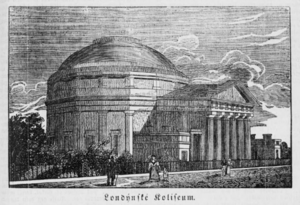London Colosseum facts for kids
The London Colosseum was a really cool building that used to stand near Regent's Park, London. It was built way back in 1827. Its main purpose was to show off an amazing artwork: a giant painting called the "Panoramic view of London." This painting was created by Thomas Hornor and was the biggest painting ever made at the time!
The building itself looked a bit like the famous Pantheon in Rome. Sadly, the London Colosseum was taken down in 1875.
Contents
The London Colosseum: A Giant Art Show
The idea for the Colosseum came from an English artist named Thomas Hornor. He wanted a special place to display his huge painting of London. Hornor had made drawings for this painting from the very top of St Paul's Cathedral. He was up there when the cross and ball on the dome were being replaced in 1821–22.
Hornor's plan was to create a 360-degree painting inside a huge dome. This dome was built in Regent's Park. It looked like the Roman Pantheon, not the Roman Colosseum. Building such a grand place was very expensive. One of its main supporters, Rowland Stephenson, even had to leave the country in 1828 because of the costs. Hornor followed him soon after.
The Colosseum was located on the east side of Regent's Park. It was between Chester Terrace and Cambridge Terrace. The building was designed by Decimus Burton, with help from John Young. It had 16 sides and a large dome. It was made of brick, covered with cement to look like stone.
How the Giant Painting Was Made
The artist E. T. Parris started working on the panorama on December 12, 1825. He used Hornor's drawings from St. Paul's Cathedral as his guide. This project was a huge challenge for Parris, both artistically and technically.
Parris began by drawing the outlines in chalk. He made them 16 times larger than the original drawings. This meant the final painting would be 256 times bigger in area! It was a lot of hard work, but he finished the outlines by April. Then, the actual oil painting began.
Hornor hired other artists to help Parris. However, they struggled with the unique type of work needed. There were problems with colors matching and the overall look. Parris decided to take charge and do most of the painting himself. He got help from several house-painters, and this turned out to be a good decision.
Painting such a massive canvas was difficult. Parris also had trouble reaching all parts of it. He was very clever and invented special light scaffolds, bridges, and platforms. Sometimes he hung from the roof by ropes! He even fell twice from high up, but luckily, he wasn't seriously hurt.
The panorama was finally finished in November 1829, after four years of work. It was the largest painting ever created, covering over 40,000 square feet. It showed Parris's amazing artistic skill and determination.
New Owners and Exciting Changes
After a while, Hornor faced money problems. The Colosseum was sold in May 1843 for 23,000 guineas. It was then updated by William Bradwell, who was a chief machinist from the Covent Garden Theatre. He added a new entrance and a corridor inspired by the Vatican.
The new owners opened a "Glypoteca, or Museum of Sculpture." It displayed more than 180 sculptures by famous artists. The old tent-like decorations were replaced with a beautiful dome made of thousands of pieces of glass. The museum's decorations included a copy of a famous procession from the Parthenon. There were also 20 colorful paintings by Mr. Absalom.
The lift, called "the Ascending Room," could carry ten or twelve people. It was now decorated in an old English style and lit by colorful stained-glass windows. E.T. Parris even repainted "The Grand Panorama of London" for the reopening in 1845. He added more details that he couldn't include the first time.
Other fun attractions were added. The conservatories were decorated in a fancy "arabesque" style. They had a "Gothic Aviary" in the middle. An "Exterior Promenade" featured fake classical ruins. It showed how much beauty could be created in a small space.
Visitors could also see a "Chalet or Swiss Cottage." From its window, they could look at real waterfalls. These were set against a painted background of the Mer de Glace and Mont Blanc. There was also a "Stalactite Cavern," built to look like a real cave in Germany.
In the evenings, a different panorama of London was shown. It was painted by Danson and Telbin. Special light effects made the city look realistic at night. Later, a night view of Paris was shown from 1848. A panorama of the lake of Thun in Switzerland followed in 1850. In 1848, a fancy theatre was added. It showed a ten-scene cyclorama about the 1755 Lisbon earthquake.
The End of the Colosseum
In 1855, the Colosseum and its cyclorama were put up for auction. About £200,000 had been spent on the building over the years. However, the highest bid was only £20,000.
The building changed hands several times. Eventually, some gentlemen bought it, hoping to build a grand hotel. But this idea was dropped. Later, a Mr. Bird bought the lease. The building was then completely torn down in 1875. The land was empty until the Cambridge Gate was built there between 1876 and 1880.
Images for kids
See also
- George Chambers (1803–1840), a marine painter, was one of the artists who worked on the panorama.



